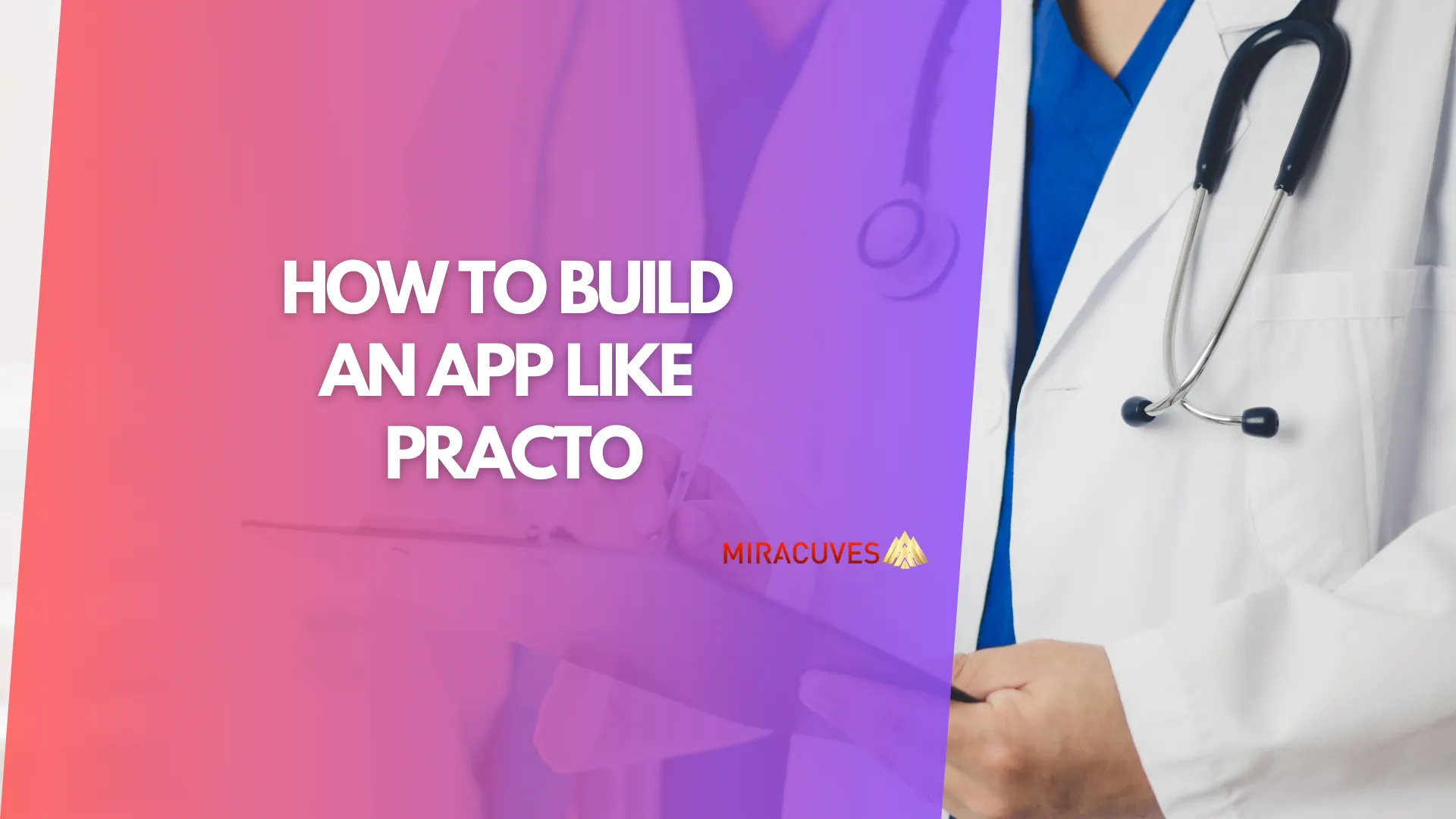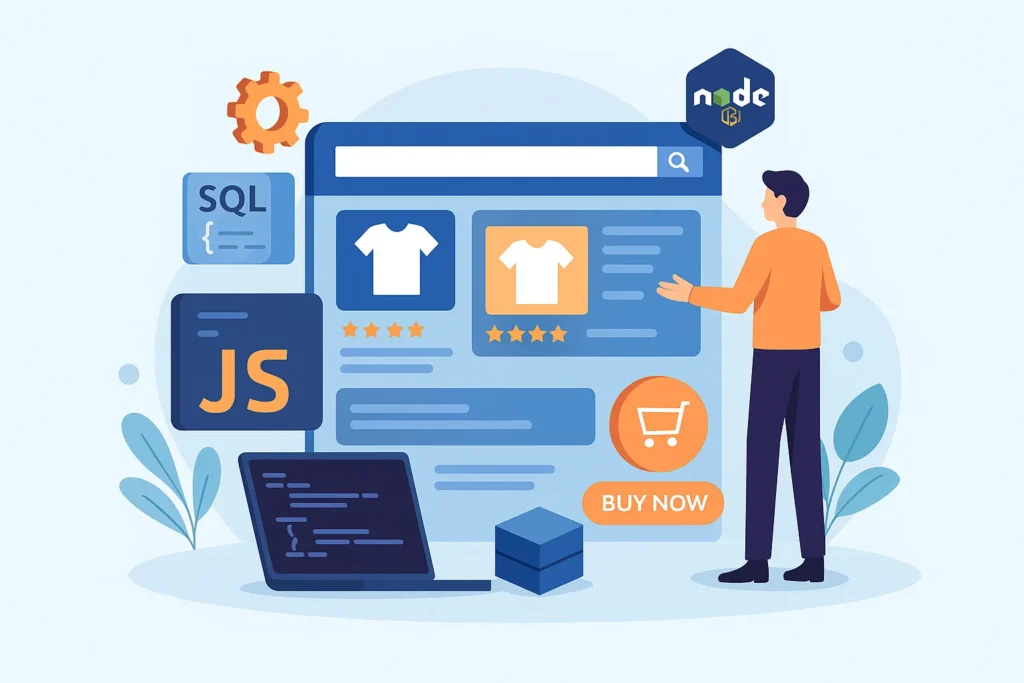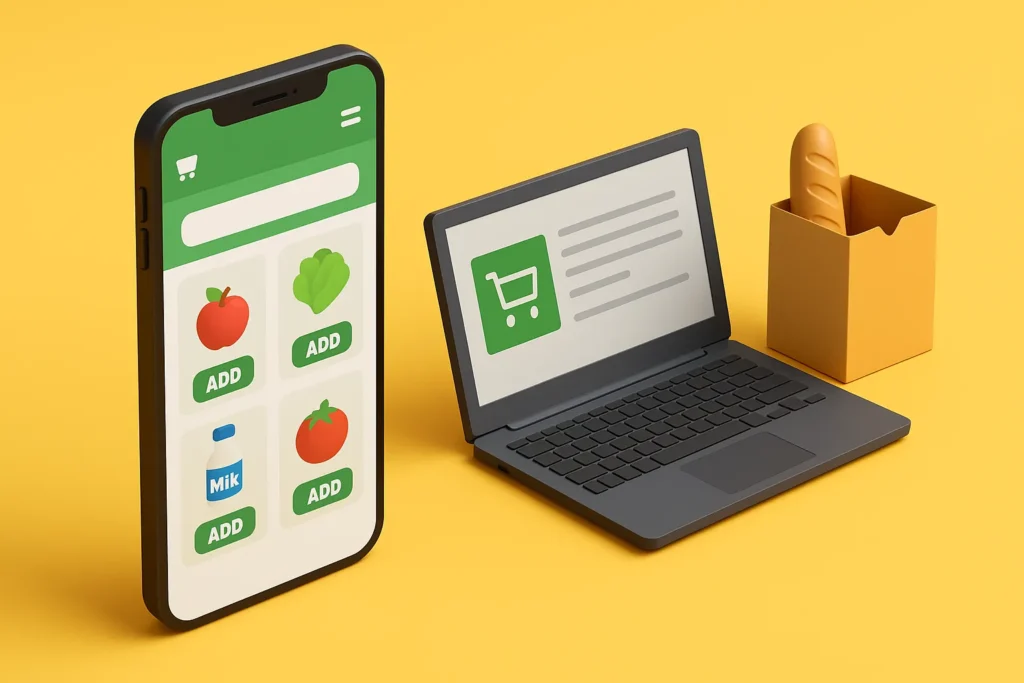The world of healthcare is rapidly evolving, and telemedicine has emerged as a powerful tool for making healthcare more accessible. In today’s digital age, people prefer consulting doctors online, booking appointments through apps, and managing their health without leaving home. One of the most prominent players in this space is Practo, which allows users to schedule doctor appointments, consult physicians online, access medical records, and even order medicines – all in one platform.
Building an app like Practo offers exciting business opportunities, not only to meet growing healthcare demands but also to revolutionize virtual healthcare services. As more people embrace telehealth platforms, developing a remote healthcare app that functions seamlessly and provides value to both doctors and patients is crucial. With the right strategy, you can create a Practo alternative that is both cost-efficient and feature-rich.This guide provides a step-by-step approach to building a telemedicine app with ready-made templates and cost-effective solutions. Whether you’re an entrepreneur, healthcare provider, or tech company, this article will walk you through the features, development process, costs, and strategies needed to build an app that competes with Practo and delivers superior virtual healthcare experiences.
What is Practo, and What Does It Do?
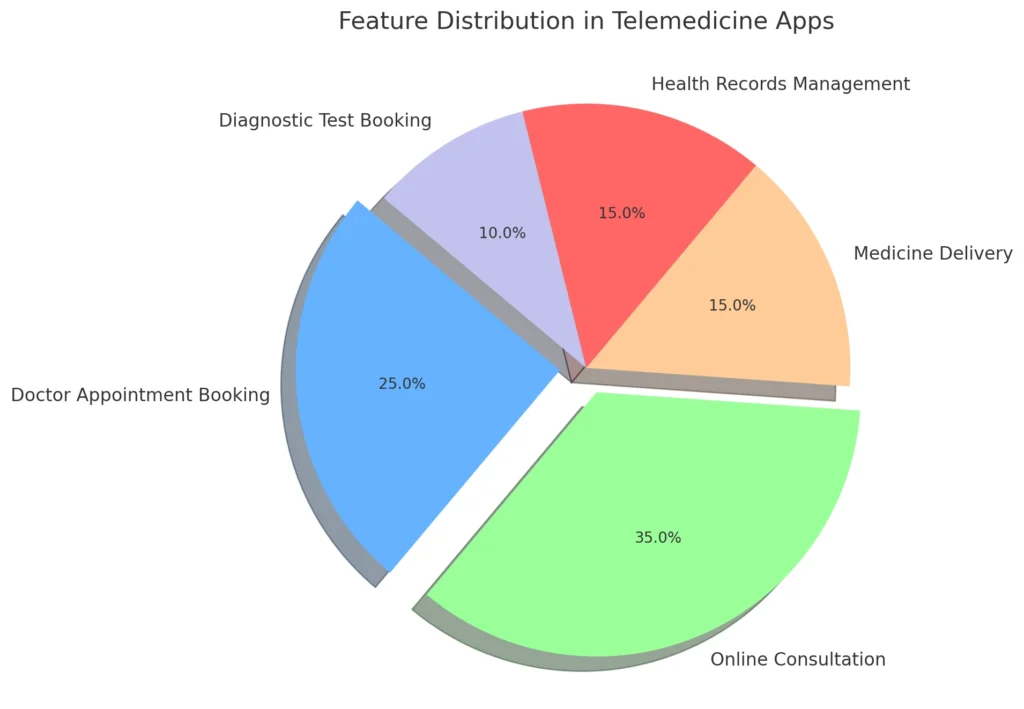
Practo is a leading telemedicine platform that connects patients with healthcare professionals, making it easy to consult doctors online, book appointments, manage health records, and order medicines from pharmacies. It functions as a one-stop solution for individuals seeking healthcare services remotely, without needing to visit a clinic or hospital in person.
The platform offers two core services:
- Doctor Appointment Booking: Users can search for doctors based on specialties, locations, and ratings. They can schedule appointments at clinics or for virtual consultations directly through the app.
- Online Consultations: Practo enables real-time communication with doctors via chat, call, or video, making healthcare accessible from anywhere.
Beyond consultations, Practo’s additional features include medicine delivery, diagnostic test bookings, and access to digital health records, ensuring continuity of care. This app bridges the gap between patients and healthcare providers by combining convenience, trust, and efficiency.
With the shift toward online healthcare services, building an app like Practo provides a chance to enter the growing telemedicine market, offering innovative solutions to improve patient experiences and outcomes.
Why Should You Build This App?
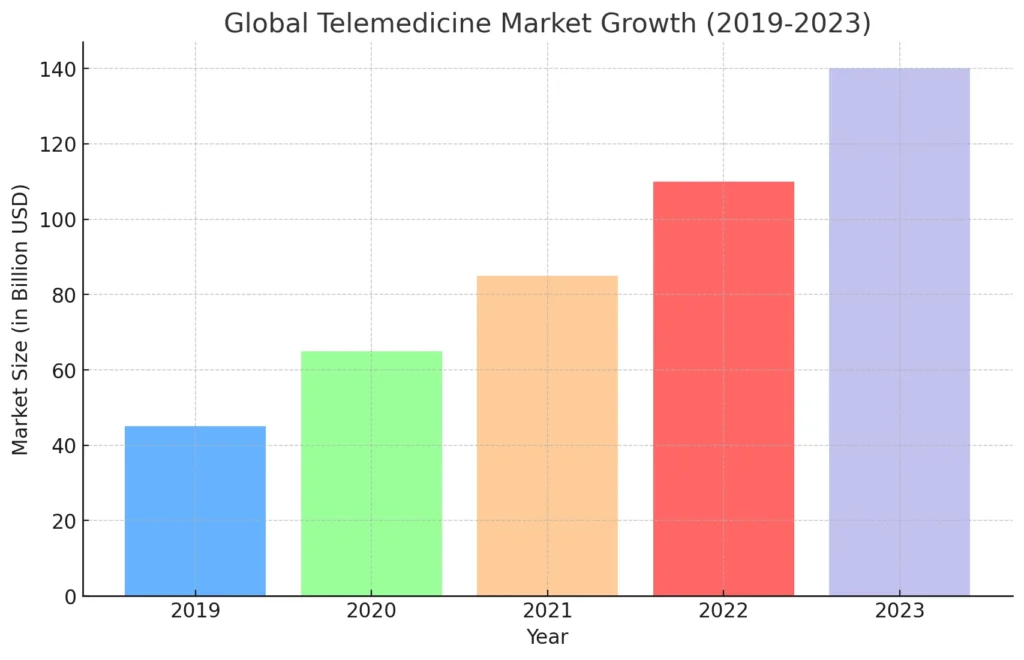
The global shift towards online healthcare services has made apps like Practo essential for modern medical care. With patients increasingly seeking virtual consultations, easy appointment scheduling, and access to medical records, telemedicine platforms are no longer a luxury—they are a necessity. If you’re considering building a similar app, here are key reasons why this is a smart business move:
- Growing Market Demand
The demand for telemedicine has skyrocketed, fueled by the need for remote healthcare solutions. Patients now prefer virtual consultations for minor health issues, eliminating the need for physical visits. - Convenience and Accessibility
A healthcare app provides 24/7 access to doctors and medical services. It ensures that patients can receive medical advice regardless of their location, which is crucial in emergencies or for rural areas with limited healthcare infrastructure. - Cost-Efficiency for Patients and Providers
Virtual healthcare apps reduce operational costs for medical providers by minimizing the need for physical infrastructure. Patients also save on travel and waiting times, making healthcare more affordable and efficient. - High Revenue Potential
Telemedicine apps offer multiple revenue streams such as subscription plans, pay-per-consultation models, and commission on diagnostic tests or medicine deliveries. With the right strategy, your app can generate steady income while improving healthcare access. - Rapid Innovation and Future Scalability
The industry is continuously evolving with AI-driven diagnostics and wearable tech integration. Starting with a Minimum Viable Product (MVP) ensures you enter the market quickly and allows for continuous improvements and scalability in the future.
By building an app similar to Practo, you can tap into the fast-growing telehealth sector and make a meaningful impact on how healthcare services are delivered.
Also Read:- How to Build a Trusted Telemedicine Platform like HealthTap
How to Differentiate Your App from Competitors
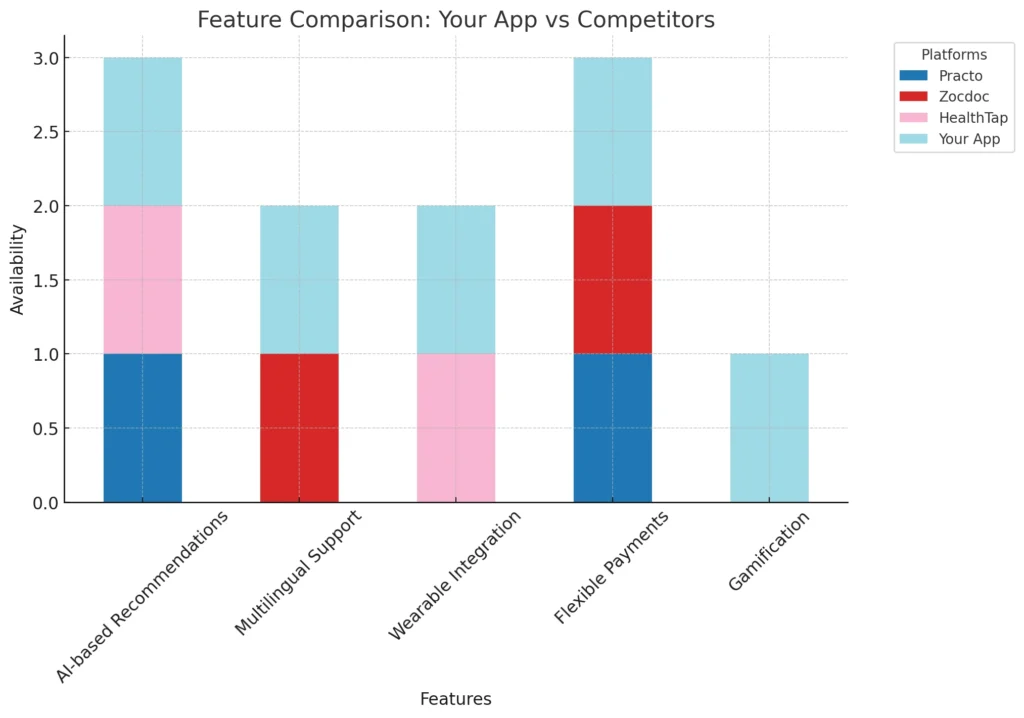
The healthcare app market is competitive, with established players like Practo, Zocdoc, and HealthTap leading the way. To build a successful app, you need to stand out by offering unique features that enhance user experience and provide added value to both patients and healthcare providers. Here are some strategies to differentiate your app:
- Personalized Health Recommendations
Integrate AI-based features that provide users with personalized health advice and reminders based on their medical history, prescriptions, and past consultations. This adds a proactive touch to healthcare. - Multilingual Support
Offering the app in multiple languages ensures accessibility to diverse populations, especially in regions with multiple spoken languages. This can enhance user engagement and trust. - Integration with Wearables
Connect your app with wearable devices (like fitness trackers and smartwatches) to monitor vital signs such as heart rate, blood pressure, or sleep patterns. This promotes continuous care and engages health-conscious users. - Flexible Payment Options
Introduce a variety of payment methods like subscription plans, pay-per-consultation models, and wallet options. Additionally, offer insurance integrations to attract users seeking covered healthcare services. - Gamification Elements
Engage users with gamification features like reward points for healthy activities or milestone achievements. This not only motivates users to stay active but also encourages continuous usage of the app.
By combining these innovative elements, your app can carve out a niche in the telehealth market, offering something unique that competitors don’t.
Market Size, Growth, and Revenue Model
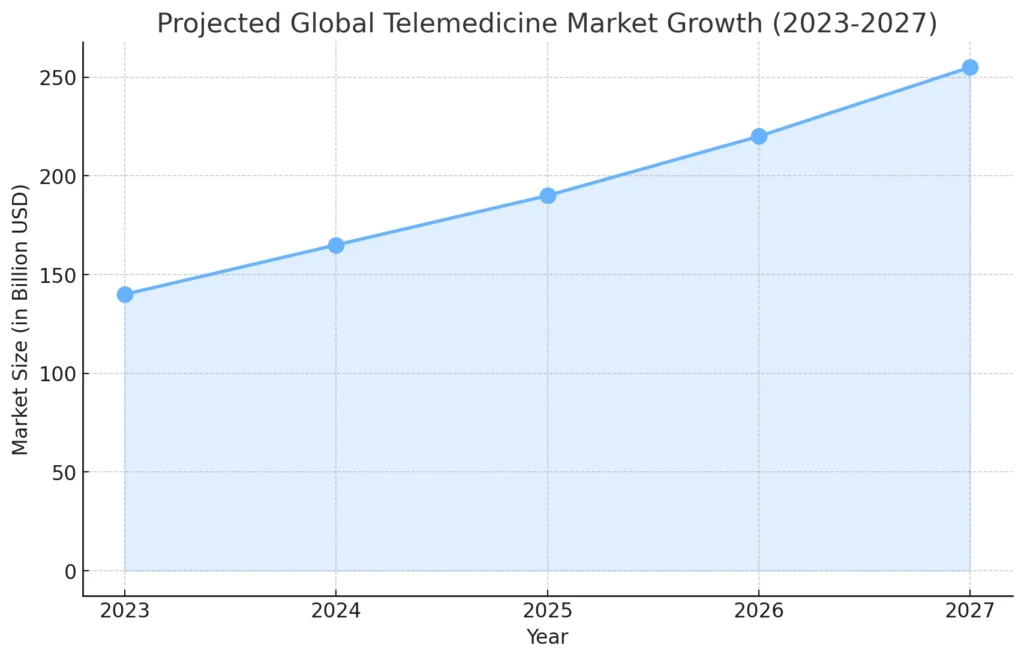
The telemedicine market is witnessing exponential growth, driven by increasing demand for remote healthcare solutions and technological advancements. With virtual consultations and online healthcare services becoming the norm, building a platform like Practo positions your business at the forefront of this booming industry.
- Global Market Size and Growth
The global telemedicine market was valued at $140 billion in 2023 and is expected to grow at a compound annual growth rate (CAGR) of 15-20% over the next five years. This rapid expansion is fueled by factors like rising healthcare costs, demand for remote access, and convenience. - Key Market Drivers
- Increased adoption of teleconsultation due to the COVID-19 pandemic.
- Growing smartphone and internet penetration, making healthcare apps accessible.
- Support from governments and insurance companies for telemedicine services.
- Revenue Model for Telemedicine Apps
A telemedicine app like Practo can generate revenue through multiple streams:- Subscription Plans: Offer users premium features with a monthly or yearly subscription.
- Pay-per-Consultation: Charge a flat fee for every doctor consultation.
- Commission from Pharmacies and Labs: Earn commission on medicine delivery and diagnostic test bookings.
- Advertisements: Collaborate with healthcare providers and brands for in-app ads.
Investing in a virtual healthcare platform now will provide access to a growing user base and multiple monetization opportunities, setting your business on a path to success.
Also Read:- Essential Security Features for Healthcare Apps
Features of the App
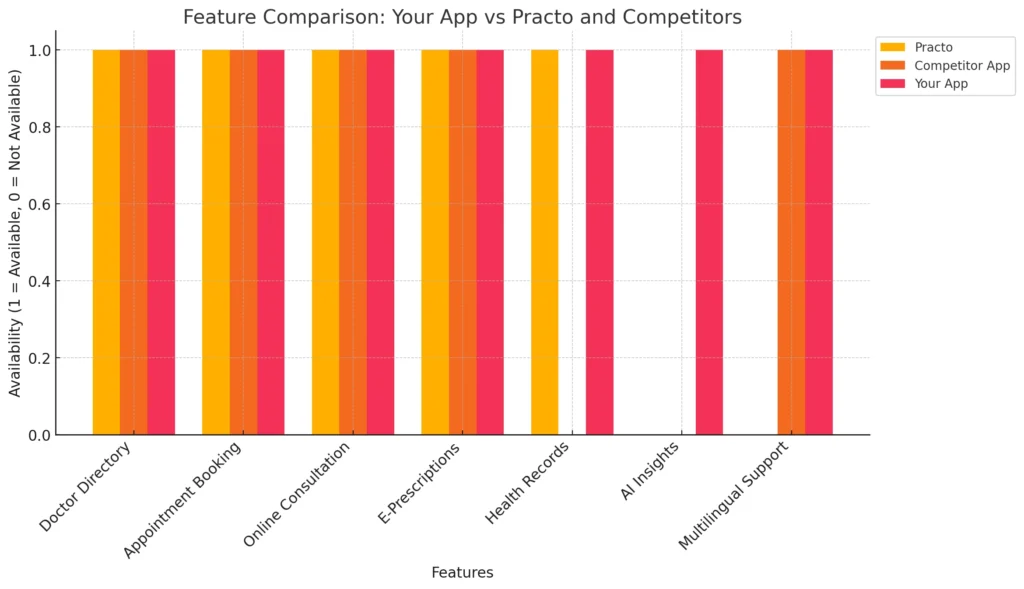
To build a successful telemedicine app like Practo, you need to integrate features that offer both functionality and convenience for users and healthcare providers. Here is a breakdown of the essential and advanced features your app should have:
Core Features
- Doctor Directory and Search
- Users can search for doctors by specialty, location, and availability.
- Filters allow sorting by ratings, experience, and consultation fees.
- Appointment Booking
- Seamless booking for both in-person and virtual appointments.
- Appointment reminders through push notifications and SMS.
- Online Consultation via Chat, Call, or Video
- Real-time communication with healthcare professionals.
- Secure chat history and prescription management.
- E-Prescriptions and Medicine Orders
- Doctors can issue e-prescriptions directly through the app.
- Option to order medicines online with home delivery services.
Advanced Features
- Health Records Management
- Users can store and access medical history, lab reports, and prescriptions in one place.
- Doctors can view patient records for better diagnosis.
- Payment Integration
- Multiple payment methods, including credit cards, wallets, and UPI.
- Option for users to claim insurance for consultations.
- AI-Driven Health Insights
- Personalized health tips and alerts based on user behavior.
- AI algorithms to recommend doctors and services.
- Multilingual and Accessibility Options
- App available in multiple languages to serve a wider audience.
- Accessibility features for users with special needs.
By focusing on these features, your app can provide a seamless healthcare experience that attracts users and ensures high engagement and retention.
Also Read:- How Practo’s Monetization Model Powers Online Healthcare Consultations
Technical Requirements
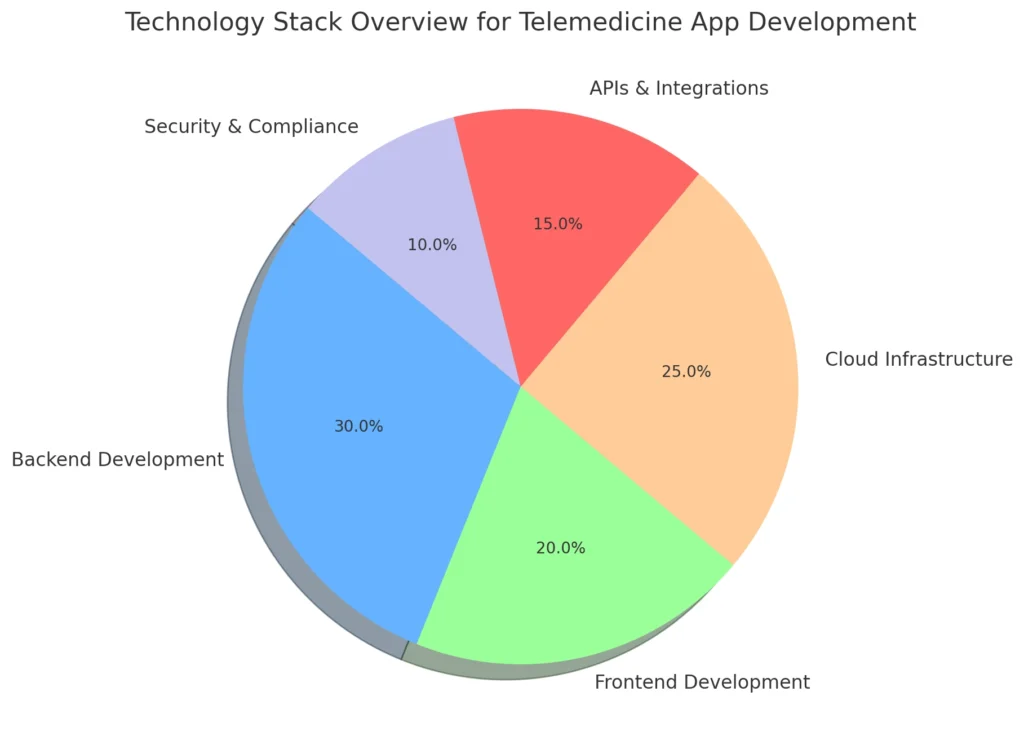
Building a robust and scalable telemedicine app like Practo requires choosing the right technology stack and infrastructure. It’s essential to ensure the app operates smoothly across multiple platforms (iOS, Android, and Web) while maintaining security, speed, and user experience. Below is a breakdown of the key technical components needed:
Backend Development
- Node.js or Django for server-side logic to handle multiple requests seamlessly.
- RESTful APIs to connect the backend with mobile and web platforms.
- Database Management: Use MongoDB or MySQL to store user data and health records securely.
Frontend Development
- React Native or Flutter for building cross-platform mobile apps.
- HTML5, CSS3, and JavaScript frameworks (like React) for web app development.
Cloud Infrastructure and Hosting
- Amazon Web Services (AWS) or Google Cloud Platform (GCP) for scalable hosting solutions.
- Cloud storage for health records and diagnostic reports to ensure accessibility anytime.
APIs and Integrations
- Google Maps API for location-based search and appointment bookings.
- Payment Gateways such as Stripe or PayPal for secure transactions.
- Video Call API (e.g., Twilio) for real-time consultations.
Security and Compliance
- End-to-End Encryption (E2EE) to protect patient data during consultations.
- HIPAA Compliance to ensure the app meets healthcare data privacy regulations.
- Two-Factor Authentication (2FA) for secure user login and access.
A well-planned tech stack ensures your telemedicine app delivers speed, reliability, and security, meeting the expectations of both patients and healthcare providers.
From video consultations to health tracking
Our platform can power your telemedicine app like
Practo can helps you to track your healthcare.
Design and User Interface
The design and user interface (UI) of a telemedicine app play a crucial role in delivering a seamless healthcare experience. Users expect the app to be intuitive, responsive, and easy to navigate, ensuring quick access to doctors, appointments, and health records. Here are key elements to consider when designing a telemedicine app like Practo:
Key Design Elements
- User-Centric Layout
- Keep the design simple and intuitive, with easy access to core features like consultations and bookings.
- Minimal clicks: Users should be able to book appointments in three steps or fewer.
- Responsive Design for All Devices
- Ensure the app is responsive across mobile phones, tablets, and web browsers.
- Focus on cross-platform compatibility using frameworks like Flutter or React Native.
- Attractive and Accessible Interface
- Use a clean color palette with soothing tones that align with healthcare services.
- Implement accessibility features, including large fonts and voice commands for visually impaired users.
- Personalized User Experience
- Display personal health reminders, appointment history, and relevant doctors based on the user’s medical history.
- Use push notifications to alert users about appointments, prescriptions, and test results.
- Secure Login and Navigation
- Include two-factor authentication (2FA) to protect user data.
- Provide easy login with social media accounts or biometrics (like Face ID).
A well-designed app ensures user engagement and retention, making it easier for patients to trust the platform for their healthcare needs.
Development Process
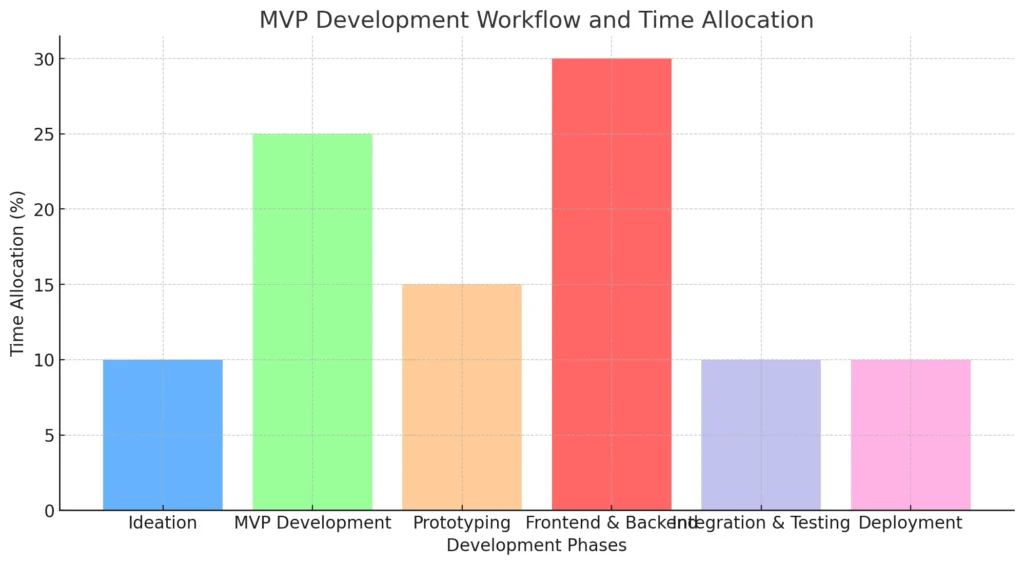
Building a telemedicine app like Practo requires a structured development process to ensure smooth functionality and timely delivery. Following a step-by-step workflow helps break the project into manageable phases, starting with the MVP (Minimum Viable Product) and scaling up with advanced features. Here’s how the development process unfolds:
Step-by-Step Workflow
- Ideation and Market Research
- Begin by identifying market needs and defining the core problem your app will solve.
- Analyze competitors to determine gaps and unique features that will set your app apart.
- MVP Development
- Focus on essential features such as doctor search, appointment booking, and online consultation for the initial launch.
- An MVP helps you test the waters with minimum investment and allows for quick feedback-based iterations.
- Prototyping and UI/UX Design
- Create wireframes and prototypes to visualize the app’s layout and user flow.
- Conduct usability tests to ensure the design aligns with user expectations.
- Frontend and Backend Development
- Use React Native or Flutter for frontend to ensure smooth, cross-platform functionality.
- Implement robust backend solutions with Node.js or Django and connect with APIs for payment, maps, and video consultations.
- Integration and Testing
- Test the app across multiple devices and platforms to identify bugs and performance issues.
- Ensure integration with essential APIs like Twilio for video calls and Google Maps for location-based search.
- Deployment and Launch
- Deploy the app on Google Play Store, Apple App Store, and web platforms.
- Monitor post-launch performance to gather user feedback and fine-tune the app.
The development process ensures your app is built efficiently, meeting user needs while staying on time and within budget. Starting with an MVP also reduces risks and provides a faster path to market entry.
Cost Estimation and Timeframe
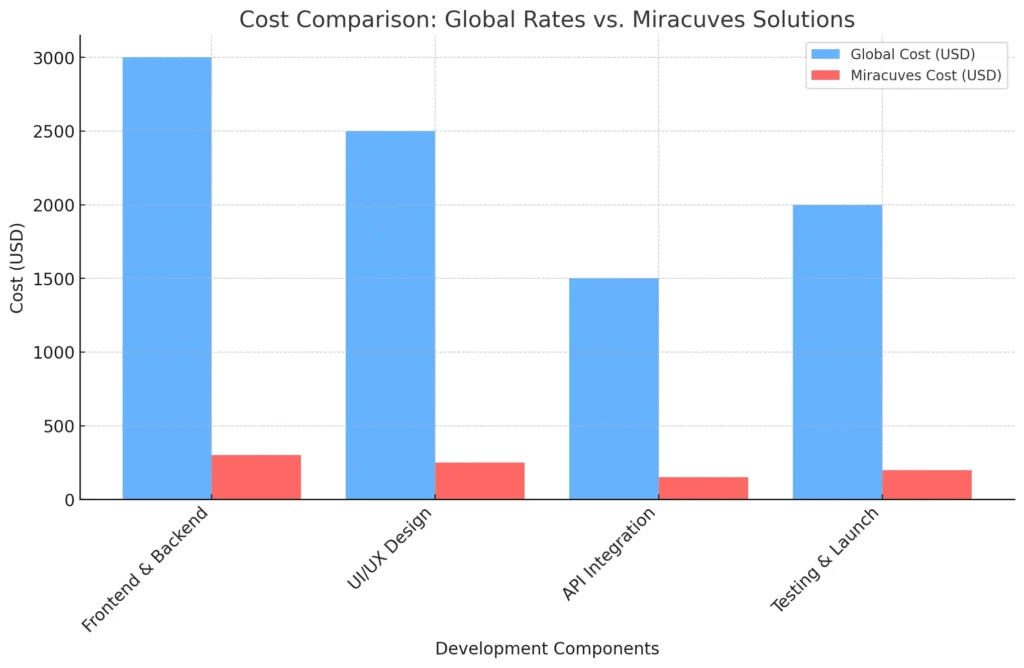
When it comes to building a telemedicine app like Practo, understanding the cost and time involved is essential. While the global cost of development can be significant, efficient solutions can reduce both expenses and timelines without compromising quality. Below is an estimate of the costs and timeframes for developing key components of the app.
Global vs. Miracuves Solutions Cost Comparison
- Global Development Cost: $6,000 to $12,000 for a basic telemedicine app.
- Miracuves Solutions: Delivers the same app at just 10% of the global cost, i.e., $600, without compromising on features.
Timeframe Comparison
- Global Timeframe: App development typically takes 4 to 8 weeks, depending on complexity.
- Miracuves Solutions: Streamlines the development process and delivers the app in just 1 day, 30x faster than the global standard.
Cost Breakdown of Key Components
- Frontend and Backend Development:
- Global: $2,000 – $4,000
- Miracuves Solutions: ~$200
- UI/UX Design and Prototyping:
- Global: $1,500 – $3,000
- Miracuves Solutions: ~$150
- API Integrations (Payment, Video Calls):
- Global: $1,000 – $2,000
- Miracuves Solutions: ~$100
- Testing and Launch:
- Global: $1,500 – $3,000
- Miracuves Solutions: ~$150
Miracuves Solutions offers cost-effective, high-quality development without compromising speed. This makes it an ideal partner for startups and businesses seeking to enter the telemedicine market efficiently.
Why Trust Miracuves Solutions for Your Next Project?
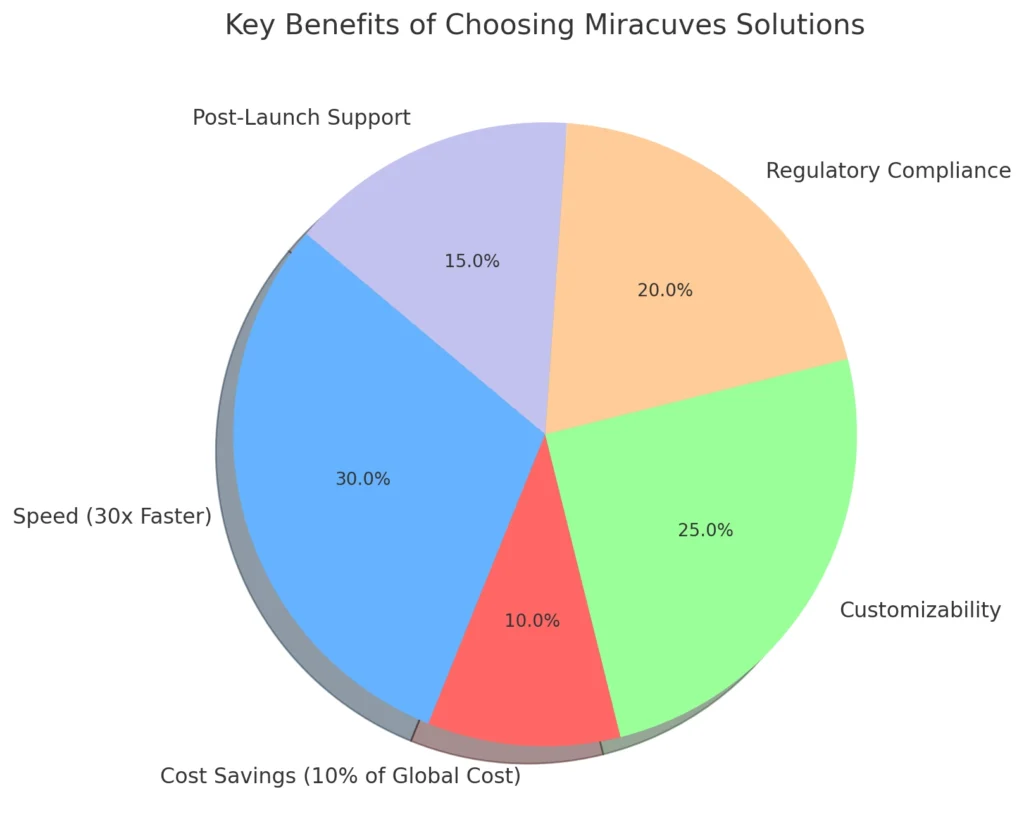
Choosing the right development partner is crucial to the success of your telemedicine app. Miracuves Solutions has built a reputation for delivering high-quality apps at a fraction of the cost and time required by other providers. Here’s why trusting Miracuves Solutions is the smartest choice for your next project:
1. Proven Expertise in Healthcare App Development
Miracuves Solutions has extensive experience in building telehealth platforms that meet industry standards. Their team understands the nuances of developing healthcare solutions, ensuring your app is functional, secure, and user-friendly.
2. Unmatched Speed and Cost Efficiency
With Miracuves Solutions, you’ll get your app delivered 30x faster than the industry average – within 1 day instead of 1 month. At just 10% of the global cost, Miracuves ensures affordable yet feature-rich solutions.
3. Customizable and Scalable Designs
Miracuves offers ready-made templates that can be tailored to fit your unique needs. Whether it’s adding AI-driven insights or integrating with wearable devices, their solutions are flexible and future-proof.
4. Secure and Compliant Development
Healthcare apps need to comply with strict data privacy laws like HIPAA. Miracuves Solutions ensures end-to-end encryption, two-factor authentication (2FA), and regulatory compliance, protecting your users’ sensitive data.
5. Reliable Post-Launch Support
Their commitment doesn’t end with deployment. Miracuves Solutions provides ongoing support, updates, and maintenance to ensure your app stays ahead in the competitive healthcare market.
By choosing Miracuves Solutions, you not only save time and money but also gain a trusted partner dedicated to your project’s success. Contact Us Today!!
Monetization Strategies
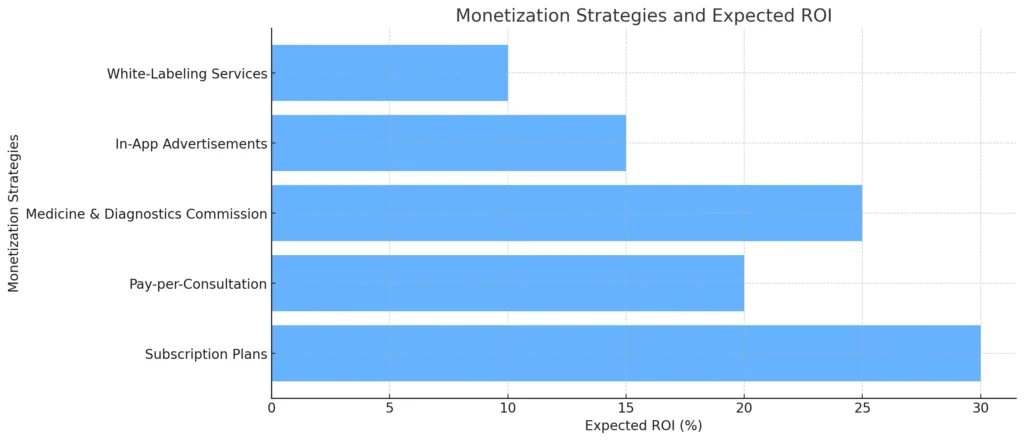
Developing a telemedicine app is not just about providing healthcare; it’s also a lucrative business opportunity. With the right monetization strategies, your app can generate steady revenue while delivering value to users. Here are the top ways you can monetize a telemedicine platform like Practo:
1. Subscription Plans
- Offer monthly or yearly premium plans that unlock advanced features such as unlimited consultations, health tracking, and priority bookings.
- Users are willing to pay for added convenience and access to exclusive doctors or specialists.
2. Pay-per-Consultation
- Charge users for one-time consultations with doctors.
- This model works well for non-regular users and provides an option to consult specialists without committing to subscriptions.
3. Commission on Medicines and Diagnostics
- Partner with pharmacies and diagnostic labs to provide medicine delivery and test booking services.
- Take a commission on each order placed through the app.
4. In-App Advertisements
- Collaborate with healthcare brands and pharmaceutical companies to display non-intrusive ads.
- Offer targeted advertising based on user behavior, ensuring relevance and engagement.
5. White-Labeling Services
- Offer your app as a white-label product to healthcare providers or hospitals looking to launch their own branded platform.
- This can generate significant revenue through licensing and custom development.
A well-rounded monetization strategy ensures your app stays financially sustainable while providing users with value. Combining multiple revenue streams will help you diversify and maximize profit potential.
Launching and Marketing the App
Launching your telemedicine app successfully requires careful planning and strategic marketing to reach your target audience. A well-executed launch ensures your app gains visibility and attracts users from day one. Below are the essential steps for launching and marketing your app effectively:
Pre-Launch Preparation
- App Store Optimization (ASO)
- Optimize your app listing with relevant keywords, engaging descriptions, and high-quality screenshots to rank higher in app store searches.
- Create a Pre-Launch Buzz
- Leverage social media platforms and healthcare forums to build excitement before the launch.
- Offer early access to influencers or beta testers, encouraging them to share feedback and generate buzz.
Post-Launch Marketing Strategies
- SEO and Content Marketing
- Develop blogs and informative articles around topics like telemedicine trends or health tips, targeting keywords like “online doctor consultation” or “build app like Practo.”
- Use backlinks and guest posts to drive organic traffic to your website.
- Social Media Campaigns
- Run targeted ads on Facebook, Instagram, and LinkedIn to attract healthcare professionals and users.
- Share customer testimonials, case studies, and app walkthroughs to increase trust and engagement.
- Influencer and Email Marketing
- Collaborate with healthcare influencers to promote your app.
- Use email marketing campaigns to engage with existing users and offer discounts on premium services.
- Offer Discounts and Referral Programs
- Encourage users to invite friends by offering referral bonuses or discounts on consultations.
- Implement limited-time offers to attract early adopters.
Launching and marketing your app effectively helps it gain traction quickly and ensures sustainable growth in a competitive market.
Legal and Regulatory Considerations
When building a telemedicine app, it’s essential to comply with legal and regulatory requirements to protect patient data and avoid legal issues. Healthcare apps handle sensitive medical information, so ensuring data privacy and compliance with industry laws is critical for user trust and operational safety.
Key Regulations to Consider
- HIPAA Compliance (for the U.S. Market)
- Your app must follow HIPAA (Health Insurance Portability and Accountability Act) guidelines to ensure the privacy of patient data.
- This includes secure storage, encrypted data transmission, and access control.
- GDPR Compliance (for the European Market)
- If your app operates in Europe, it must adhere to the General Data Protection Regulation (GDPR), focusing on user consent, data protection, and transparency.
- Local Healthcare Regulations
- Check country-specific healthcare laws to ensure your app complies with local licensing and medical practice regulations.
- Data Encryption and Secure Authentication
- Implement end-to-end encryption (E2EE) for data protection and two-factor authentication (2FA) for secure user login.
- Ensure that only authorized personnel can access sensitive health data.
- Medical Liability and Disclaimers
- Provide clear terms and conditions and disclaimers to outline the scope of your app’s responsibilities.
- Consult legal experts to develop medical liability agreements for healthcare providers using the platform.
Complying with these legal and regulatory requirements not only helps you avoid penalties and legal troubles but also builds trust among users and healthcare providers, which is crucial for long-term success.
Directs to a reliable source providing comprehensive guidance on GDPR compliance.
Future Growth and Trends
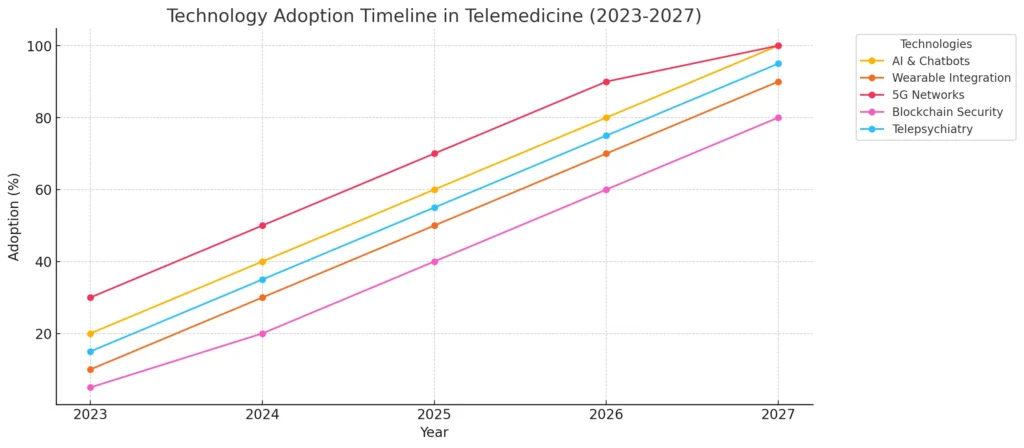
The telemedicine industry is evolving rapidly, with new technologies and trends shaping its future. As more people rely on virtual healthcare services, there are several exciting opportunities to explore. Building an app like Practo not only taps into the current demand but also positions your business to benefit from upcoming innovations.
Key Trends Shaping the Future of Telemedicine
- Artificial Intelligence (AI) and Machine Learning (ML)
- AI-powered chatbots are becoming popular for symptom checking and appointment scheduling, reducing the workload for healthcare professionals.
- Machine Learning algorithms will offer personalized health recommendations based on user data and past consultations.
- Wearable Technology Integration
- Telemedicine apps are increasingly connecting with wearable devices (like smartwatches and fitness trackers) to monitor patients’ vital signs in real-time.
- This integration helps doctors offer continuous care and early detection of health issues.
- 5G Networks for Better Connectivity
- The rollout of 5G technology ensures faster data transmission, improving the quality of video consultations and real-time communication between doctors and patients.
- Blockchain for Data Security
- Blockchain technology will play a significant role in enhancing data security by offering decentralized storage and preventing unauthorized data access.
- This innovation ensures greater transparency and trust among users.
- Telepsychiatry and Mental Health Services
- The demand for mental health consultations through telemedicine platforms is increasing. Offering telepsychiatry services as part of your app can unlock a new revenue stream.
- Remote Patient Monitoring (RPM)
- Future apps will enable doctors to monitor chronic conditions remotely, using connected devices that provide real-time health data.
Opportunities for Growth
- Expansion into New Markets: Telemedicine is not limited to urban areas. Expanding services to rural regions and underserved communities offers a massive opportunity.
- Value-Based Care Models: Future healthcare will shift towards outcome-based models, meaning apps will focus more on improving patient outcomes rather than just delivering services.
- Global Collaborations: Partnering with international healthcare providers will allow apps to offer cross-border consultations and second opinions.
The future of telemedicine promises exciting developments. Staying ahead of these trends ensures your app remains competitive and adaptable in the ever-changing healthcare landscape.
The World Health Organization (WHO) provides trusted insights into digital health trends, including telemedicine.
Conclusion
Building a telemedicine app like Practo presents an incredible opportunity to make healthcare more accessible, efficient, and affordable. With the right technology, user-centric design, and thoughtful monetization strategies, you can create a platform that meets the needs of both patients and healthcare providers.
Telemedicine is no longer just a trend—it’s the future of healthcare. As people continue to rely on virtual consultations, secure health records, and remote monitoring, launching a healthcare app that delivers seamless experiences puts you ahead of the curve.
Partnering with Miracuves Solutions ensures that your project is executed 30x faster and at just 10% of the global cost. With expertise in customized solutions and post-launch support, Miracuves Solutions empowers you to bring your vision to life efficiently and at scale.
With the right strategy, compliance, and future-proof technology, your app can become a trusted name in the world of virtual healthcare.
Want to build a healthcare app like Practo?
Our expert team can help you create a platform for online consultations, appointment bookings, and health management.
FAQs
How much does it cost to build an app like Practo?
The global cost for developing a telemedicine app ranges from $6,000 to $12,000. However, with Miracuves Solutions, you can get the same app built at 10% of the global cost—just $600.
Can I customize the templates provided by Miracuves Solutions?
Yes, Miracuves Solutions offers ready-made templates that are fully customizable. You can tailor them to meet your specific requirements and add advanced features as needed.
How long does it take to develop a healthcare app?
Globally, the development process can take between 4 to 8 weeks. However, Miracuves Solutions delivers your app in just 1 day, making it 30x faster than traditional development timelines.
Is the app compliant with healthcare regulations?
Absolutely. Miracuves Solutions ensures that your app is HIPAA and GDPR compliant, with end-to-end encryption and secure authentication features to protect user data.
What makes Miracuves Solutions unique for app development?
Miracuves Solutions stands out with its ability to provide cost-efficient, fast, and scalable solutions. They specialize in delivering healthcare apps at a fraction of the global cost with ongoing support and future-proof technology.
Check out our powerful healthcare app solutions offered by Miracuves – built for reliability and scale:
Netmeds Clone Solution– Effortless online pharmacy management with doorstep delivery, prescription uploads, and secure payment integration.
PharmEasy Clone Solution– Comprehensive medicine ordering platform with diagnostic booking, lab integration, and user-friendly navigation.
Lybrate Clone Solution– Health Q&A and expert consultation system with personalized recommendations, privacy-first design, and medical content discovery.
Practo Clone Solution – All-in-one doctor appointment booking with video consultations, patient records, and real-time scheduling.



